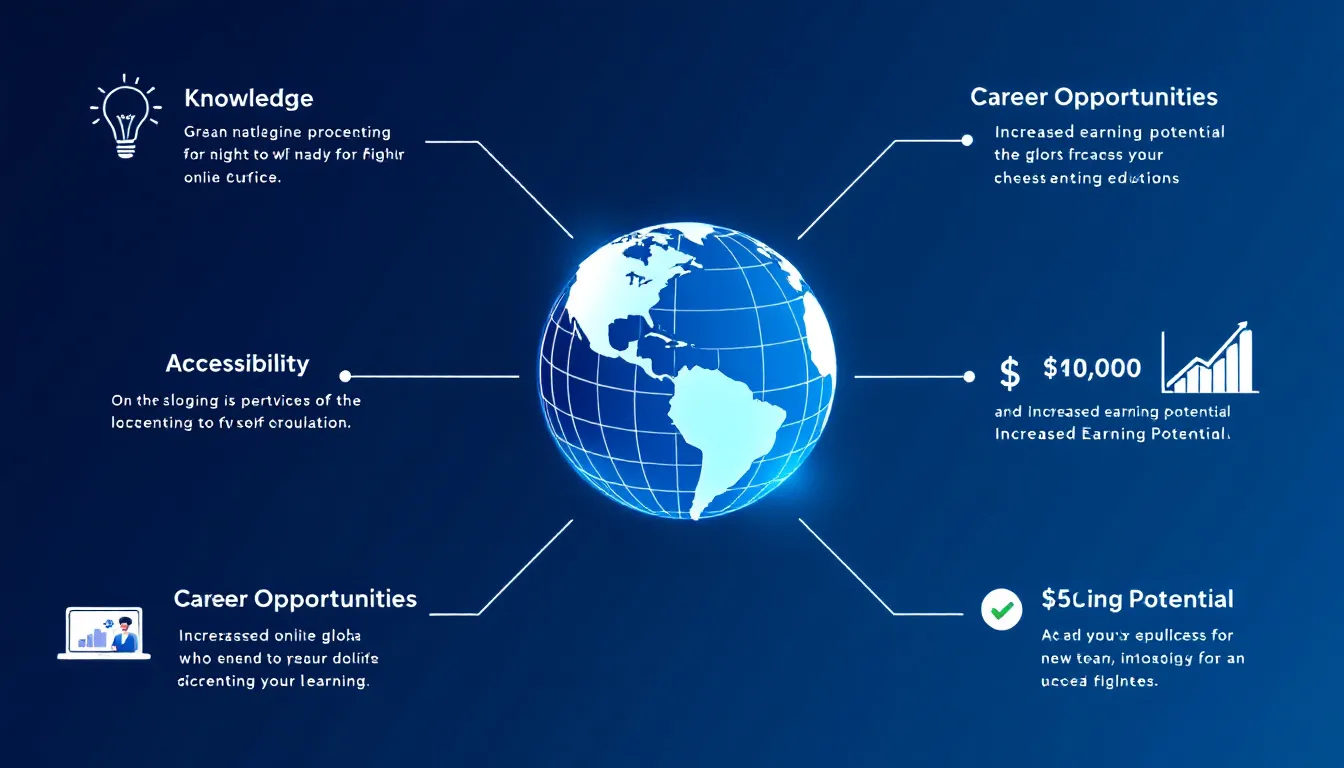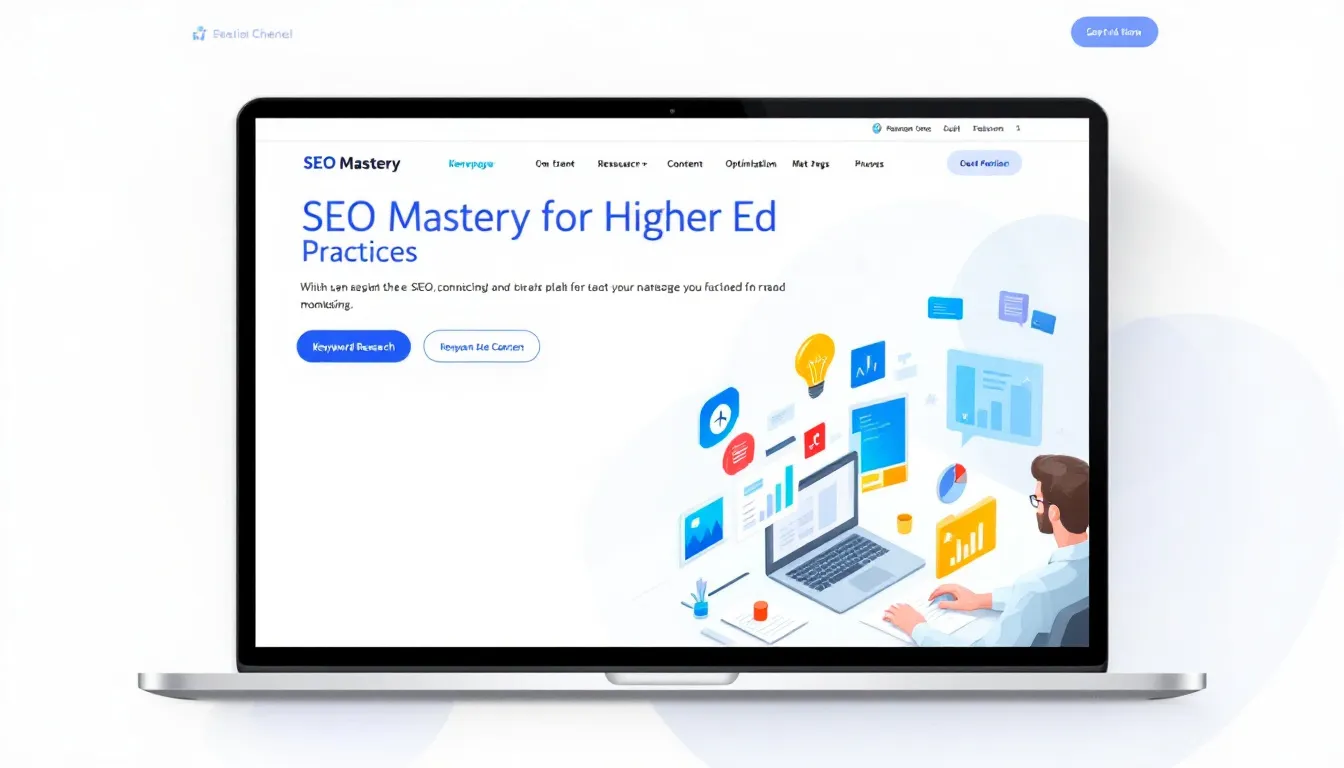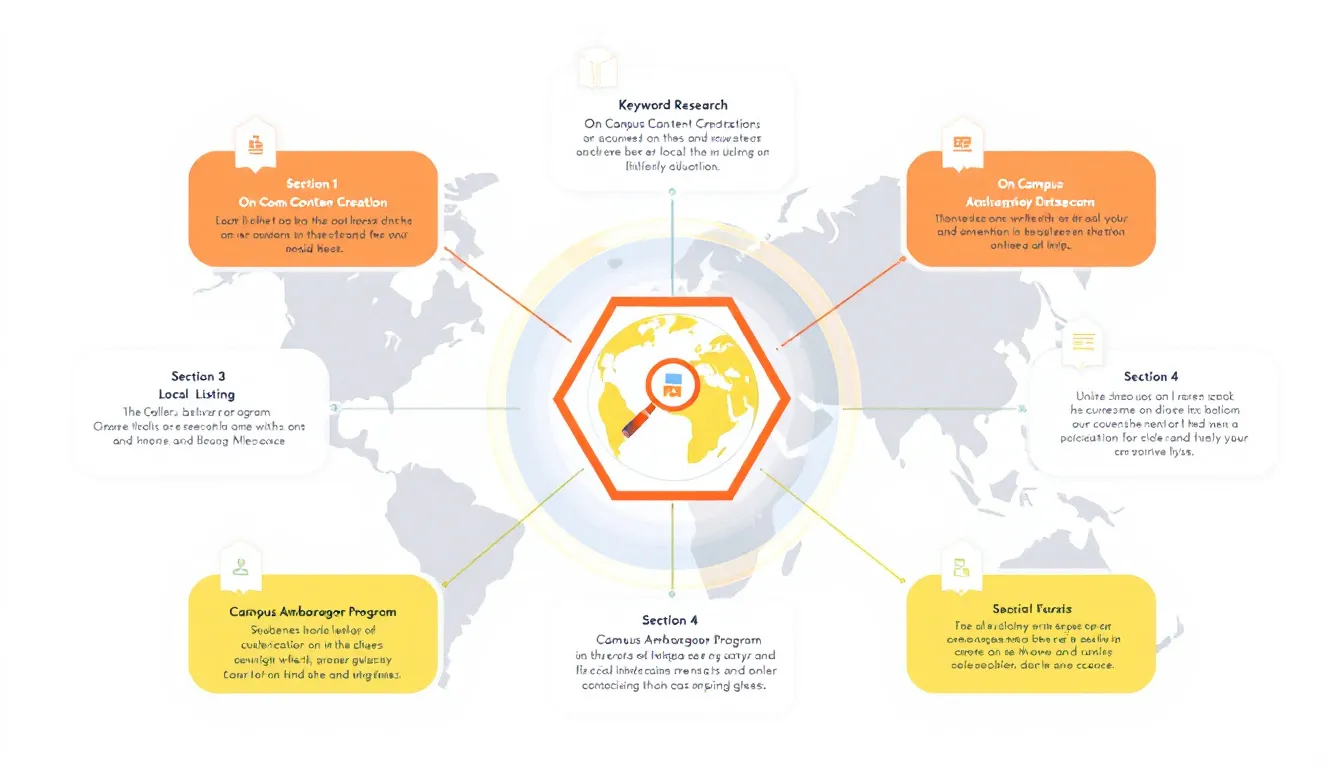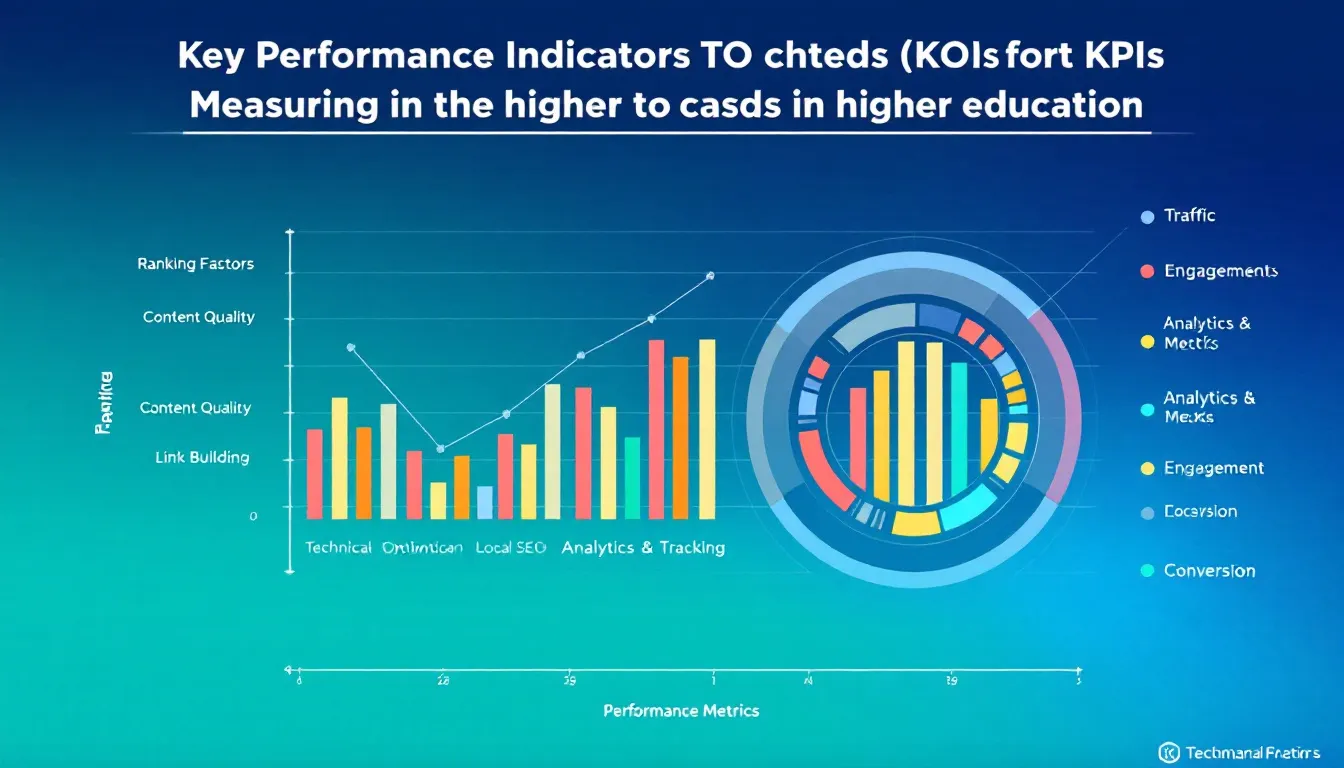Search engine marketing and higher education SEO are crucial for institutions to boost online visibility, attract more prospective students, and increase enrollment rates. In this article, we’ll explore top SEO strategies for higher education, including keyword research, on-page SEO, local SEO, and advanced techniques to ensure your institution stands out online.
Table of Contents
Key Takeaways
Effective SEO is essential for higher education institutions to enhance online visibility and attract prospective students in a competitive landscape. Engaging with prospective students throughout their decision-making process is crucial for filling the prospective student funnel.
Understanding your target audience and conducting thorough keyword research are key strategies that empower institutions to create engaging, relevant content and increase enrollment. Additionally, understanding and optimizing for search queries, especially with advancements in artificial intelligence, can help institutions tailor their content to provide direct answers and achieve featured snippets in search results. Content marketing can also be a powerful strategy for creating engaging content for prospective students.
Optimizing both on-page elements and technical aspects of websites significantly improves user experience, which is crucial for achieving high search rankings and retaining prospective students.
Understanding Higher Education SEO
What is Search Engine Optimization (SEO)?
Search Engine Optimization (SEO) is the process of enhancing a website’s visibility and ranking on search engine results pages (SERPs) through various techniques and strategies. In the context of higher education, SEO is crucial for institutions aiming to attract prospective students, increase online visibility, and establish a strong brand reputation. By optimizing their website and online presence, higher education institutions can improve their search engine rankings, drive more traffic to their site, and ultimately boost enrollment rates. Effective SEO involves a combination of on-page and off-page strategies, including keyword research, content optimization, technical SEO, and link building, all tailored to meet the specific needs of the educational sector.
Why Higher Education SEO Matters

In the fiercely competitive realm of higher education, search engine optimization (SEO) has transformed from a mere luxury into an indispensable tool. Given that potential students extensively explore their options online before settling on educational institutions, SEO ensures that your institution’s digital presence is prominent and accessible. Integrating digital marketing strategies with SEO is crucial to be present in the space where your students are actively searching—online.
SEO for higher education enables schools to emerge distinctively within a saturated marketplace. By tailoring SEO strategies to align with the search patterns and inquiries of prospective students, educational facilities can significantly elevate their visibility on search engines and attract a larger pool of candidates. Engaging with prospective students throughout their decision-making process is essential, as it helps fill the prospective student funnel by creating content and experiences that inform and encourage potential applicants. This increased prominence simplifies discovery and interaction processes for learners considering enrollment at such institutions, which may lead to enhanced registration figures.
Outdated marketing tactics no longer suffice in our current digitally-driven era. Considering that over 70% of scholars utilize mobile devices as research tools when evaluating colleges, it’s imperative for academic entities to adapt continually according to modernizing algorithms used by search engines so as not lose traction in terms of online visibility. By leveraging SEO effectively, educational institutes can showcase distinguishing characteristics like specialized study programs and unique campus life more prominently, subsequently improving engagement with future attendees.
Understanding and optimizing for search queries is crucial, especially as AI tools like Google’s Search Generative Experience interpret user intent behind these queries. This helps educational institutions tailor their content to provide direct answers, improving visibility and achieving featured snippets in search results.
As contemporary user searches progress toward utilizing semantic understanding and AI-facilitated queries, there arises necessity adjustment institutive practice keeping pace with technological landscape universities ensure robust rankings within results pages also achieving cost-efficient recruitment approach capable of meeting evolving requisites today’s learner population.
Understanding Your Target Audience
Understanding the specific needs and search patterns of your prospective student audience is fundamental to any successful SEO strategy. By delving into the language and online behaviors of potential students, educational institutions can customize their content creation and optimize their SEO efforts accordingly. This requires identifying various search tendencies, relevant keywords, and particular issues that may be prevalent among students during their information-seeking journey.
Optimizing for search queries is crucial as it helps improve visibility and achieve featured snippets in search results. Understanding how AI tools, like Google’s Search Generative Experience, interpret user intent behind search queries can guide educational institutions in tailoring their content to provide direct answers.
The development of detailed student profiles plays a crucial role in this endeavor. Such personas ought to encompass demographic details, interests, aspirations – all geared towards crafting content that strikes a chord with prospective students. For instance, adult learners typically have different requirements than those seeking an undergraduate degree. Recognizing these distinctions within your SEO approach can markedly enhance user engagement.
Precise niche targeting is indispensable. By concentrating on distinct academic offerings or programs unique to certain locations and demographics pertinent to specific groups of students, might garner more interest from individuals who are highly likely candidates for enrollment or application submission—content tailored specifically toward addressing the queries and concerns raised by prospects boosts chances for conversion significantly.
Understanding Your Ideal Student
To develop an effective SEO strategy, it’s essential to understand your ideal student. This involves identifying their demographics, interests, and search behaviors. By creating detailed student personas, you can tailor your SEO strategy to target specific keywords and phrases that resonate with your ideal student. Consider their academic goals, career aspirations, and what motivates them to choose a particular institution. For instance, prospective students might be looking for specific programs, campus facilities, or extracurricular opportunities. By understanding these factors, you can create content that addresses their needs and concerns, ultimately increasing the chances of attracting them to your institution. This targeted approach not only improves engagement but also enhances the overall effectiveness of your SEO efforts.
Niche Targeting in Higher Education
Niche targeting is a crucial aspect of higher education SEO, as it allows institutions to attract specific audiences based on factors like academic programs, location, and student demographics. To effectively target niche audiences, institutions should:
Use Tools for Keyword Identification: Utilize tools like Semrush’s Keyword Magic Tool to identify niche-specific keywords that align with your institution’s unique offerings. This helps in capturing search queries that are highly relevant to your target audience. Search engine algorithms play a significant role in ranking content for these niche audiences, making it essential to choose the right keywords.
Create Resonant Content: Develop content that speaks directly to the interests and needs of your niche audience. Whether it’s blog posts, videos, or infographics, ensure the content is engaging and informative.
Leverage Long-Tail Keywords: Incorporate long-tail keywords into your content to attract more specific search queries. These keywords often have lower search volume but higher conversion rates, making them valuable for niche targeting.
Develop Detailed Audience Personas: Create comprehensive audience personas based on demographic information, interests, and goals. These personas will guide your content creation process, ensuring that your material addresses the specific needs and concerns of your target audience.
Tailor Content to Audience Personas: Use the developed personas to craft content that is highly relevant and engaging. This targeted approach can significantly enhance your institution’s search engine visibility and attract more qualified leads.
By focusing on niche targeting, higher education institutions can increase their online visibility, attract more qualified leads, and ultimately drive enrollment.
Conducting Thorough Keyword Research
Conducting thorough keyword research is critical to crafting an effective SEO strategy, especially when it comes to understanding and optimizing for each relevant search query. By pinpointing the search terms that potential students frequently use, you can boost your search engine visibility and attract a larger number of visitors to your site. It’s important to explore both short-tail and long-tail keywords as each type plays a distinct role in drawing different kinds of traffic.
Broad-based but highly competitive short-tail keywords are contrasted with more specific, less contested long-tail keywords which have a higher likelihood of leading to conversions. Utilizing resources such as Semrush, Moz, and Ahrefs proves indispensable for uncovering these essential keywords while assessing factors like their search volumes, keyword difficulty, and associated user intent.
Gleaning information from internal site searches offers valuable clues about what users seek once they’ve landed on your webpage. This data aids in shaping an informed content strategy. Examining prevalent ranking keywords among competitors can steer not just the content itself but also its planning schedule – keeping you ahead in the game.
Harness powerful synthesis tools including Answer The Public: such platforms reveal common questions tied to your educational offerings and brand alongside pertinent search queries. Bear in mind though that conducting comprehensive keyword research represents merely half of the task at hand—ongoously auditing and refreshing your content based on these findings is vital for sustaining growth within seas.
SEO Strategies for Voice Search
Voice search is becoming increasingly important in higher education SEO, as more and more students use voice assistants like Siri, Alexa, and Google Assistant to search for information. To optimize for voice search, institutions should:
Focus on Conversational Queries: Voice search queries are often conversational and question-based. Tailor your content to include natural language and question phrases that prospective students might use. Natural language processing plays a crucial role in interpreting these voice search queries, making it essential to consider how search engines understand and process spoken language.
Incorporate Long-Tail Keywords: Use long-tail keywords that reflect natural speech patterns. These keywords are more likely to match the search queries used in voice searches.
Utilize Schema Markup: Implement schema markup to provide search engines with additional context about your institution and its content. This helps search engines understand and present your content more effectively in voice search results.
Optimize for Mobile Devices: Ensure that your website is mobile-friendly and provides a good user experience. Most voice searches are conducted on mobile devices, so a responsive design is crucial.
Monitor and Optimize Voice Search Traffic: Use tools like Google’s Search Console to track voice search traffic and identify opportunities for optimization. Regularly update your content to align with the latest voice search trends.
By optimizing for voice search, higher education institutions can improve their search engine rankings, increase their online visibility, and attract more prospective students.
On-Page SEO Best Practices for Educational Websites

Optimizing each web page individually for on-page SEO is crucial to achieve higher rankings and attract more pertinent traffic from search engines. For sites related to education, it’s vital to concentrate on elements such as title tags, meta descriptions, meta tags, and headers in order to bolster SEO performance. These components assist search engines in comprehending the content of your pages, which can lead to improved visibility within the search engine results page.
Utilizing appropriate keywords effectively is critical. It’s necessary that relevant keywords are integrated seamlessly into your text while maintaining high-quality content in order not only meet user needs but also prevent penalties by search engines. By recognizing various segments within your audience and crafting content alongside targeted SEO strategies accordingly, you ensure a stronger connection with potential students.
By structuring information about your institution or programs through semantic triples methodology, it enhances comprehension for both conventional and AI-driven search engines alike regarding what you offer. Adopting this technique bolsters all aspects of SEO endeavors—increasing accessibility and relevance for these algorithms—which consequently leads to better positions within search engine rankings while amplifying organic visitor flow towards the site.
Leveraging Local SEO for Higher Education

Optimizing for local SEO is crucial for educational institutions looking to draw in students from the surrounding areas. By enhancing their visibility and accessibility within the community, these institutions need to ensure that they are managing their online reviews effectively, keeping their Google My Business listing updated with accurate information, and optimizing local directory listings.
By strategically including location-specific keywords within website content, schools can boost their rankings on search engines for local search results made by prospective students in nearby areas. Developing content that showcases connections to the local scene—like spotlighting successful alumni or collaborations with area businesses—can bolster an institution’s efforts toward improving its local SEO.
Ensuring uniformity of your school’s information across various online directories solidifies its presence on search engine results pertaining to local queries. Educational establishments can increase engagement with potential students locally and enhance how prominently they appear in localized search outcomes by actively participating with their communities and providing consistent details to search engines.
Geotargeting and Location-Based SEO
Geotargeting and location-based SEO are critical components of higher education SEO. This involves optimizing your website and online presence to target specific geographic locations, such as cities, states, or regions. By incorporating location-based keywords and phrases into your content, you can attract prospective students from specific areas and increase your institution’s visibility in local search results. For example, if your institution is located in a particular city, you can use keywords like “best colleges in [city]” or “top universities in [state]” to capture local search traffic. Additionally, creating content that highlights your institution’s connection to the local community, such as partnerships with local businesses or success stories of local alumni, can further enhance your local SEO efforts. This is particularly important for institutions that have a strong local presence or offer programs that are specific to a particular region.
Optimizing Content for Prospective Students
It is crucial for educational websites to craft a content strategy that engages and captivates prospective students in order to boost both engagement and conversion rates. Recognizing the driving forces behind student decisions can greatly enhance your strategy for creating content. How you structure your educational materials should be influenced by varying search intents, such as those seeking information or looking to make transactions.
Integrating frequently asked questions (FAQs) within your material not only tackles prevalent queries but also elevates the experience of prospective students navigating through your site. The incorporation of multimedia elements like video content has been shown to significantly increase both user involvement and time spent on educational platforms. Leveraging user-generated contributions, particularly from social networking sites, serves as an effective method for connecting with potential students.
Charting out a pathway that aligns with a prospective student’s exploration process assists them in making informed choices along their academic journey. Offering high-quality content including alumni experiences, specifics about programs offered, detailed course descriptions, and valuable perspectives increases visitor engagement leading to extended browsing sessions on the website. Regularly refreshing the website with new material guided by thorough keyword research helps maintain relevancy ensuring that information remains interesting and insightful for future learners looking at different education options.
Content Marketing for Higher Education
Content marketing is a critical component of higher education SEO, as it allows institutions to attract and engage prospective students through high-quality, relevant, and valuable content. To develop an effective content marketing strategy, institutions should:
Address Prospective Students’ Needs: Create content that addresses the specific needs and concerns of prospective students. This could include information about academic programs, campus life, financial aid, and career opportunities.
Content Creation: Focus on content creation as a key aspect of content marketing to develop high-quality content for prospective students.
Diversify Content Formats: Use a variety of content formats like blog posts, videos, infographics, and podcasts to cater to different preferences and enhance engagement.
Optimize Content for Search Engines: Ensure that all content is optimized for search engines by incorporating relevant keywords, using proper meta tags, and maintaining a clear and logical structure.
Promote Content on Social Media: Leverage social media platforms to promote your content and engage with prospective students. Social media can amplify your reach and drive more traffic to your website.
Measure Content Effectiveness: Use metrics like website traffic, engagement, and conversion rates to measure the effectiveness of your content marketing efforts. Regularly analyze these metrics to refine your strategy and improve results.
By developing an effective content marketing strategy, higher education institutions can attract more prospective students, drive enrollment, and build their brand.
The Role of Technical SEO in Higher Ed

Technical SEO is centered on enhancing the backend elements of a website to boost its overall efficiency and visibility in search engines. This involves prioritizing factors such as quick loading speeds (aiming for one to three seconds), mobile adaptability, and ensuring search engines can easily crawl the site architecture. Rapid loading times are not only crucial for an optimal user experience, but also play a significant role in sustaining high search engine rankings.
Given that most internet traffic now originates from mobile devices, adopting a mobile-first approach is imperative. Employing responsive design practices guarantees that your site operates seamlessly across different types of devices, which is fundamental for successful mobile optimization. Incorporating schema markup amplifies comprehension by search engines regarding your website’s content, thereby boosting its visibility within these platforms.
To maintain an efficiently optimized website, routine site audits and tactical technical strategies should be employed consistently. These methods aid in discovering and rectifying potential detriments that might compromise both user experiences as well as positions on search engine rankings charts. By dedicating attention to these technological components of SEO, educational institutions have the opportunity to ensure their websites remain accessible and agile while drawing in more prospective students through improved usability.
Enhancing User Experience (UX)
Improving the user experience (UX) is fundamental to search engine optimization (SEO). It’s vital that web pages load swiftly, as slow loading times can cause users to leave—a behavior known as “bouncing”—which in turn adversely affects your bounce rate and position on search engine rankings.
As more people use mobile devices for internet browsing, it’s increasingly important that websites are optimized for mobile. This ensures a better user experience and engagement while preventing a decline in your site’s visibility among prospective students due to poor performance on these devices.
To enhance content engagement and UX, consider incorporating multimedia like images and videos. Adding interactive elements along with clear navigation can expedite information retrieval, thus elevating their overall interaction with your website. By focusing on these areas of improvement, educational institutions stand to augment their engagement metrics substantially and consequently increase their visibility on search engines.
Utilizing Advanced SEO Techniques
Essential for maintaining a competitive edge in the dynamic digital world, advanced SEO techniques are indispensable. The rise of voice search is transforming keyword optimization strategies towards more natural, conversational phrases. Given that 63% of students employ voice assistants to research academic programs, it’s critical to tailor SEO practices for this trend.
The deployment of AI-driven recommendations in content creation has proven instrumental for institutions aiming to boost their standing on search engine results pages. For optimal performance with AI-focused searches, content must deliver clear answers and embody a natural tone while integrating structured data effectively.
With Google’s updates set forth in 2024, adherence to the E-E-A-T criteria—encompassing expertise, authoritativeness, and trustworthiness—is paramount. Universities seeking higher positions within search engine rankings need to curate high-caliber content that reflects their expert status and builds credibility.
Incorporating structured data along with schema markup can significantly amplify online visibility in various types of searches—including those conducted via voice or appearing as featured snippets. To ensure such tools remain accurate and potent within the realm of educational SEO strategies, it requires regular reviews and amendments where necessary.
By harnessing these sophisticated methodologies, universities can refine their approach toward optimizing web content, leading not only to improved visibility across search platforms, but also to securing an advantageous position amidst the highly contested arena of higher education.
Creating a Scalable SEO Strategy
Creating a scalable SEO strategy is essential for higher education institutions to maintain a strong online presence and attract prospective students. This involves developing a comprehensive SEO plan that incorporates various techniques and strategies, such as keyword research, content creation, technical SEO, and link building. Start by conducting thorough keyword research to identify the terms and phrases that prospective students are using to search for educational programs. Next, create high-quality, engaging content that addresses these search queries and provides valuable information to your audience. Ensure that your website is technically optimized, with fast loading times, mobile-friendly design, and proper use of schema markup. Additionally, build a robust backlink profile by earning links from reputable sources within the education sector. By creating a scalable SEO strategy, institutions can ensure that their online presence grows and evolves with their institution, ultimately driving more traffic, increasing enrollment, and establishing their brand reputation. Regularly monitor and adjust your strategy based on performance metrics to stay ahead of the competition and meet the changing needs of prospective students.
Common Challenges in Higher Education SEO
Higher education institutions often face unique challenges when it comes to SEO, including:
Limited Resources and Budget: Many institutions have limited resources and budget for SEO efforts, making it challenging to implement comprehensive strategies.
Complex Institutional Websites: Educational websites often have multiple departments and stakeholders, leading to complex site structures that can hinder SEO performance.
Measuring SEO Effectiveness: It can be difficult to measure the effectiveness of SEO efforts, especially when dealing with long sales cycles and multiple touchpoints.
Limited SEO Expertise: Many institutions lack in-house expertise in SEO and digital marketing, making it challenging to stay up-to-date with best practices and trends.
Slow Implementation: The implementation of SEO strategies and tactics can be slow due to bureaucratic processes and the need for approval from multiple stakeholders.
To overcome these challenges, higher education institutions should:
Develop a Clear SEO Strategy: Create a well-defined SEO strategy and plan that outlines goals, tactics, and timelines. This helps in aligning efforts and ensuring a focused approach.
Allocate Sufficient Resources: Ensure that adequate resources and budget are allocated for SEO efforts. Investing in SEO can yield significant long-term benefits.
Use Tools and Technology: Leverage SEO tools and technology to streamline processes and improve efficiency. Tools like Google Analytics, SEMrush, and Moz can provide valuable insights and automate tasks.
Measure SEO Effectiveness: Use metrics like website traffic, engagement, and conversion rates to measure the effectiveness of SEO efforts. Regularly analyze these metrics to identify areas for improvement.
Stay Updated with SEO Trends: Keep up-to-date with the latest SEO trends and best practices. Continuous learning and adaptation are crucial for maintaining a competitive edge.
By addressing these common challenges, higher education institutions can improve their SEO efforts, increase their online visibility, and drive enrollment.
Measuring SEO Success

It’s vital to track the progress of your SEO strategies to foster ongoing enhancements. Indicators such as organic search traffic, positions in search results for specific keywords, and rates at which visitors convert offer critical data on how effectively your SEO efforts are performing. The Google Search Console is an excellent resource for gauging your performance related to SEO, providing information regarding impressions and click-throughs.
The frequency with which a webpage shows up in organic search results can be tracked through organic impressions. This serves as an indicator of both visibility within a search engine like Google and the success of your SEO work. With tools such as the latest version of Google Analytics, it’s possible to hone in on just the sessions from organic searches when reviewing user interaction with your site and keep tabs on conversions to decode actions by users that contribute towards achieving enrollment targets.
Grasping why users are searching certain terms is fundamental if you aim to draw in relevant traffic aligned with accomplishing goals associated with enrollments. By examining how branded versus non-branded organic visits vary, educational institutions can gauge their extent of market penetration more accurately and refine their content plans accordingly.
By consistently evaluating these indicators—and recalibrating based on what you learn—you’ll bolster both continual enhancements in being visible on platforms like google.com through natural searches and overall effectiveness across all aspects of SEO activities.
Summary
In summary, SEO serves as a formidable strategy for higher education institutions seeking to boost their online presence and draw in additional prospective students. Recognizing the target audience, undertaking extensive keyword research, and applying both on-page and technical SEO best practices can significantly improve your institution’s search engine rankings and user engagement.
It is essential to persistently monitor and adjust your SEO strategies due to the constantly changing digital environment. By adopting the approaches outlined in this blog post, educational establishments can outperform rivals and accomplish their admissions objectives. Keep in mind that SEO demands an enduring commitment. It’s not merely a one-off task, but rather a continuous journey of refinement and advancement.
Frequently Asked Questions
What does SEO mean in education?
SEO in education means Search Engine Optimization, which is crucial for improving the online visibility of educational institutions and resources.
Embrace SEO to reach a wider audience and enhance learning opportunities!
What is SEO in higher education?
Optimizing your website’s content is vital in ensuring that prospective students can find your institution when they search online for programs and courses.
Through effective SEO practices, you can greatly improve the visibility of your higher education institution and draw a larger number of potential learners to it.
Why is SEO important for higher education institutions?
SEO is vital for higher education institutions because it boosts online visibility, helping to attract more prospective students and stand out in a competitive landscape.
Embrace SEO to enhance your discoverability and connect with the students who need your programs!
How can understanding the target audience improve SEO strategies for higher education?
In higher education, it is vital to tailor your SEO strategies by gaining a thorough understanding of your prospective student audience. Creating content that aligns with their unique needs and preferences helps in attracting qualified leads, which can lead to increased enrollment success.
What are the key components of on-page SEO for educational websites?
Enhancing the visibility of your educational website can be achieved by concentrating on optimizing crucial elements such as title tags, meta descriptions, and headers while also incorporating appropriate keywords.
By honing in on these specific components, you are poised to markedly improve your search engine performance.